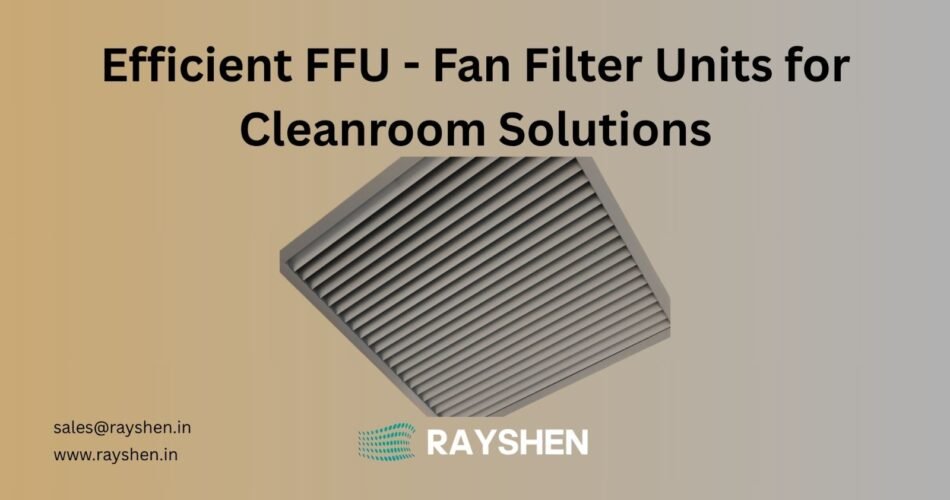Designing a clean room requires careful planning, especially when it comes to selecting the right air filtration system. Among all the essential components, the fan filter unit (FFU) plays one of the most important roles in maintaining air purity, pressure stability, and contamination control. A high-quality FFU ensures consistent airflow and HEPA-level filtration, creating a clean and controlled environment suitable for sensitive applications.
This guide explains how to choose the right FFU for your clean room design and why industries trust brands like Rayshen for reliable, high-performance clean room solutions.
Understanding the Role of a Fan Filter Unit
A fan filter unit is a self-contained system that integrates a motorized fan with a HEPA filter. It draws air in, cleans it using the HEPA filter, and then releases highly purified air into the clean room. Unlike central HVAC filtration, FFUs provide point-of-use filtration, making them ideal for environments requiring precise airflow and cleanliness levels.
FFUs are widely used in:
- Pharmaceutical manufacturing
- Biotechnology labs
- Electronics and semiconductor production
- Medical device manufacturing
- Food and cosmetic industries
Rayshen designs FFUs that meet the strict requirements of ISO-classified clean rooms, ensuring performance, durability, and clean air consistency.
Factors to Consider When Choosing a Fan Filter Unit
Selecting the right FFU is crucial for maintaining the performance and efficiency of your clean room. Here are the key considerations:
1. Determine the Required Clean Room Classification
The clean room class defines the level of cleanliness required and influences the number and capacity of FFUs needed. For example:
- ISO Class 5 and 6 rooms require more FFUs with higher airflow velocity.
- ISO Class 7 and 8 rooms require fewer units but still need stable HEPA filtration.
Knowing your classification helps you determine whether you need standard or high-performance FFUs. Rayshen manufactures FFUs suitable for all ISO levels, making them adaptable to any clean room design.
2. Check the Type and Grade of HEPA Filter
The HEPA filter is the heart of the FFU. It traps 99.97% of particles as small as 0.3 microns. When choosing an FFU, consider:
- Filter grade (H13 or H14)
- Filter efficiency
- Pressure drop
- Replacement ease
Rayshen offers FFUs with premium-grade HEPA filters that deliver consistent high-efficiency filtration, ensuring your clean room remains free from contaminants, bacteria, and fine particles.
3. Evaluate the Airflow and Velocity Requirements
Different clean rooms require different airflow patterns. FFUs typically deliver:
- Laminar (unidirectional) airflow
- Stable air velocity of 0.3–0.45 m/s
You must ensure that the FFU you choose provides:
- Smooth, uniform airflow across the work area
- Minimal turbulence
- Consistent performance during high-demand operations
Rayshen FFUs are engineered for silent, powerful airflow that supports high-precision environments.
4. Consider Energy Efficiency
FFUs run continuously, sometimes 24/7, which means energy efficiency is extremely important. Look for:
- Low-power fan motors
- Efficient HEPA filters
- Smart control panels
- Variable-speed settings
Energy-efficient models from Rayshen help reduce power consumption while maintaining superior filtration performance.
5. Noise Level and Worker Comfort
Since FFUs are ceiling-mounted and run continuously, noise level matters for operators working in the clean room. Rayshen’s fan filter units are designed to:
- Operate quietly
- Reduce motor vibration
- Improve comfort during long work shifts
Low noise levels help maintain a productive and comfortable working environment.
6. Material and Build Quality
Clean rooms must remain sterile, corrosion-free, and durable. FFUs should be made from materials that withstand chemicals and frequent cleaning.
Look for FFUs made with:
- Stainless steel
- Aluminum body
- Powder-coated steel
Rayshen ensures each fan filter unit is built with premium materials to deliver long-term reliability and easy maintenance.
7. Compatibility With Other Clean Room Equipment
Your fan filter unit must work well with the rest of the clean room system, including:
- HVAC units
- Laminar flow benches
- Clean room panels
- Air shower systems
- Monitoring and control systems
Rayshen FFUs are designed for seamless integration, making it easier to create a consistent airflow pattern throughout the facility. When paired with an air shower at the clean room entrance and HEPA filtration inside the FFUs, contamination control becomes significantly more effective.
8. Installation and Maintenance Requirements
Choose an FFU that allows:
- Quick installation
- Easy filter replacement
- Minimal downtime
- Accessible service panels
Rayshen designs FFUs with user-friendly access points, ensuring swift maintenance and reduced operational interruption.
Why Choose Rayshen Fan Filter Units for Clean Rooms?
Rayshen has become a trusted brand for clean room solutions due to its focus on:
- High-efficiency HEPA filtration
- Durable construction
- Low-noise and low-energy consumption designs
- Compatibility with ISO-class clean rooms
- Superior airflow uniformity
- Easy installation and maintenance
With years of experience and advanced engineering, Rayshen delivers FFUs designed to enhance clean room performance, safety, and operational reliability.
Conclusion
Choosing the right fan filter unit is essential for creating a clean room that is reliable, efficient, and compliant with industry standards. Consider clean room classification, HEPA filter quality, airflow requirements, noise levels, and compatibility with other equipment such as the air shower. When you select an FFU from Rayshen, you get a system engineered to deliver superior filtration, stable airflow, and long-term performance.
A well-chosen FFU not only improves air quality but also strengthens your overall contamination control strategy—ensuring a cleaner, safer, and more productive work environment.
